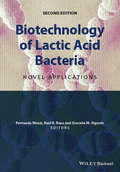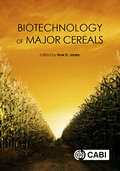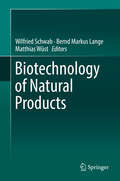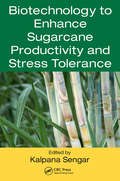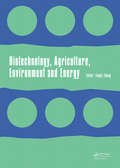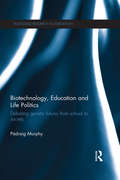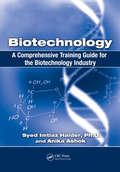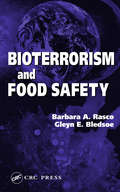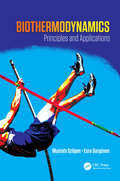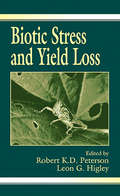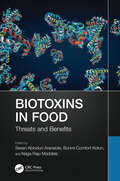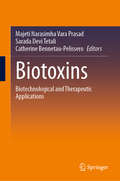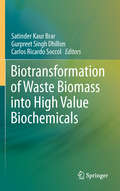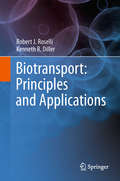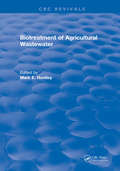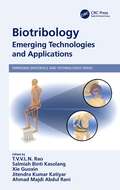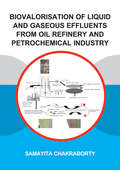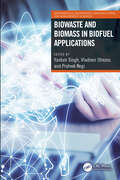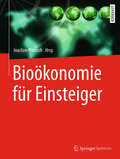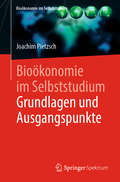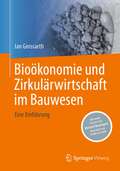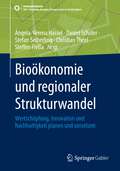- Table View
- List View
Biotechnology of Food and Feed Additives (Advances in Biochemical Engineering/Biotechnology #143)
by Holger Zorn Peter CzermakThis book review series presents current trends in modern biotechnology. The aim is to cover all aspects of this interdisciplinary technology where knowledge, methods and expertise are required from chemistry, biochemistry, microbiology, genetics, chemical engineering and computer science. Volumes are organized topically and provide a comprehensive discussion of developments in the respective field over the past 3-5 years. The series also discusses new discoveries and applications. Special volumes are dedicated to selected topics which focus on new biotechnological products and new processes for their synthesis and purification. In general, special volumes are edited by well-known guest editors. The series editor and publisher will however always be pleased to receive suggestions and supplementary information. Manuscripts are accepted in English.
Biotechnology of Lactic Acid Bacteria
by Fernanda MozziLactic acid bacteria (LAB) have historically been used as starter cultures for the production of fermented foods, especially dairy products. Over recent years, new areas have had a strong impact on LAB studies: the application of �omics� tools; the study of complex microbial ecosystems, the discovery of new LAB species, and the use of LAB as powerhouses in the food and medical industries. This second edition of Biotechnology of Lactic Acid Bacteria: Novel Applications addresses the major advances in the fields over the last five years. Thoroughly revised and updated, the book includes new chapters. Among them: The current status of LAB systematics; The role of LAB in the human intestinal microbiome and the intestinal tract of animals and its impact on the health and disease state of the host; The involvement of LAB in fruit and vegetable fermentations; The production of nutraceuticals and aroma compounds by LAB; and The formation of biofilms by LAB. This book is an essential reference for established researchers and scientists, clinical and advanced students, university professors and instructors, nutritionists and food technologists working on food microbiology, physiology and biotechnology of lactic acid bacteria.
Biotechnology of Major Cereals
by Huw D. JonesBiotechnology of Major Cereals will focus on the recent advances and future prospects in cereal biotechnology. The first part of the book will cover the world's major cereals and focus on new developments and trends. The second part will be technology rather than species-led, detailing fundamental developments in technologies and significant target traits.
Biotechnology of Natural Products
by Wilfried Schwab Bernd Markus Lange Matthias WüstThis text comprehensively covers the analysis, enzymology, physiology and genetics of valuable natural products used in the food industry that are attractive targets for biotechnological production. The focus is on the recent advances made to achieve this goal. This unique work is the first book to focus on biotechnological production of important natural products in food additives, fragrances and flavorings, vitamins and other bioactive compounds in food. The chapters offer a deep insight into modern research and the development of low molecular weight natural products. Biotechnology of Natural Products covers products in the Phenolic, Terpenoid, Vitamin and Alkaloid categories, providing a full overview of the biotechnology of food additives and other low molecular weight natural products. Gene clustering and the evolution of pathways are covered, as well as future perspectives on the topic. Due to limited oil resources and increasing consumer demand for naturalness, bioprocesses are increasingly needed to meet these requirements. Novel sophisticated technologies have facilitated the elucidation of new chemical molecules, their biosynthetic pathways and biological functions. This book provides researchers with a full overview of the technologies and processes involved in the biotechnology of natural products.
Biotechnology to Enhance Sugarcane Productivity and Stress Tolerance
by Kalpana SengarSugarcane is the most important plant source for sugar and alcohol production and is cultivated in more than 80 countries in tropical and subtropical areas. However, environmental factors negatively influence its yield and jeopardize the prospect to meet the increasing demand for sugar, other sugarcane derived by products and bioethanol. The development of stress tolerant plants is fundamental for the maintenance and increase of crop yields. Biotechnology to Enhance Sugarcane Productivity and Stress Tolerance provides a comprehensive account of both theoretical and practical aspects of sugarcane production. It contains extensive coverage of genome mapping and molecular breeding in sugarcane and presents the status of the elucidation and improvement of plant genomes of economic interest. Through 14 chapters written by eminent scientists with global influence, this book examines various methods for sugarcane improvement through biotechnology. The book focuses on genetic and physical mapping, positioning, cloning, and monitoring of desirable genes using biotechnological approaches for high sugarcane productivity and the development of stress tolerance. Additional information includes the bioengineering of sugarcane, procedures to boost productivity, genetics and assessments for resistance to drought and salinity, genetics for high yields, and various topics of research on sugarcane genetics. It serves as a detailed reference source for cane growers, sugar and sugarcane technologists, students, and professors.
Biotechnology, Agriculture, Environment and Energy: Proceedings of the 2014 International Conference on Biotechnology, Agriculture, Environment and Energy (ICBAEE 2014), May 22-23, 2014, Beijing, China.
by Fangli ZhengThe 2014 International Conference on Biotechnology, Agriculture, Environment and Energy (ICBAEE 2014) was held May 22-23, 2014 in Beijing, China. The objective of ICBAEE 2014 was to provide a platform for researchers, engineers, academics as well as industry professionals from all over the world to present their research results and development act
Biotechnology, Education and Life Politics: Debating genetic futures from school to society (Routledge Research in Education)
by Pádraig MurphyWhat should individuals and society do when genetic screening becomes widely available and with its impact on current and future generations still uncertain? How can our education systems around the world respond to these developments? Reproductive and genetic technologies (RGTs) are increasingly controversial and political. We are entering an era where we can design future humans, firstly, by genetic screening of "undesirable" traits or indeed embryos, but perhaps later by more radical genetic engineering. This has a profound effect on what we see as normal, acceptable and responsible. This book argues that these urgent and biopolitical issues should be central to how biology is taught as a subject. Debate about life itself has always been at the forefront of connected molecular, genetic and social/personal identity levels, and each of these levels requires processes of communication and debate, what Anthony Giddens called in passing life politics. In this book Pádraig Murphy opens the term up, with examples from field research in schools, student responses to educational films exploring the future of RGTs, and science studies of strategic biotechnology and the lab practices of genetic screening. Life political debate is thoroughly examined and is identified as a way of connecting mainstream education of biology with future generations. Biotechnology, Education and Life Politics will appeal to post-graduates and academics involved with science education, science communication, communication studies and the sociology of education.
Biotechnology: A Comprehensive Training Guide for the Biotechnology Industry
by Syed Imtiaz Haider Anika AshtokAll manufacturing companies face the daunting task of designing an employee training matrix that meets the gamut of national and international regulatory standards. Answering the call for a one-stop training resource that focuses exclusively on this multi-faceted, high-tech industry, Biotechnology: A Comprehensive Training Guide for the Biotechnology Industry provides ready-to-implement training templates that save time and expense without cutting corners on critical elements.Downloadable Resources: Why Reinvent the Wheel?This complete, single-source reference contains 28 complete biotechnology courses and a customizable downloadable resources with hands-on training tools. The book also provides time-saving information on how to orient employees involved in writing and executing batch manufacturing and in-process control documents.Key Benefits: Contains adaptable training text, test summaries and papers, test answers, and certificates of completion Streamlines the training process, maximizing efficiency Boosts the marketing edge over competitors This valuable training tool presents step-by-step guidance for optimizing research and development expenditures, avoiding marketing delays, gaining a competitive advantage, reducing product development failures, developing skilled manpower, and maintaining local and international regulatory compliance.
Bioterrorism and Food Safety
by Barbara A. Rasco Gleyn E. BledsoeWritten by specialists in the fields of food bioterrorism and industry preparedness, Bioterrorism and Food Safety focuses on developing rational and implementable food security strategies and plans. It integrates food safety issues, technological developments in traceability, and legal analysis of current and pending regulations with good bu
Biotherapeutics: From small to large molecules and cells (Topics in Medicinal Chemistry #42)
by Victoria Calzada Hugo Cerecetto Juan Pablo TosarThis book reviews biotherapeutics from a medicinal chemistry perspective. It covers proteins, nucleic acids, low molecular weight hormones, small peptides, extracellular vesicles, gene therapy, cell-based products, and tissue-engineered products. Expert contributors provide insights into the mechanisms of action and translational processes of biotherapeutics. Particular attention is given to the latest developments in therapeutic proteins and nucleic acids. Biotherapeutic formulation developments like encapsulation, structural modifications and nanovehiculization are also presented in this book. Divided into 15 chapters, the book begins with basic concepts and definitions of biotherapeutics from a medicinal chemistry standpoint. The following chapters focus on therapeutic proteins, monoclonal antibodies, protein production, and structural modifications. Other chapters cover topics such as antisense oligonucleotides, aptamers, mRNA, gene therapy, as well as other biotherapeutics like low molecular weight hormones and small peptides. The book concludes with an overview of biotherapeutic formulations and an authoritative discussion on regulatory aspects. Throughout the book, readers will learn how biotherapeutics, whether obtained through bioprocesses or not, impact bioresponses and can be utilized for therapeutic purposes. Given its breadth, the book appeals to researchers in medicinal chemistry and biotherapeutics, scholars of medicinal chemistry, students at all levels of biochemical studies, practitioners in the medical field, and anyone interested in biotherapeutics.
Biothermodynamics: Principles and Applications
by Mustafa Ozilgen Esra Sorguven OnerOver the past several decades there has been increasing research interest in thermodynamics as applied to biological systems. This concerns topics such as muscle work and internal energy such as fat and starch. Applications of the first and second laws of thermodynamics to the human body are important to dieticians and health science experts, and applications of these concepts to the animal body are a major concern of animal scientists. This book covers these key topics, which are typically not covered in classic or traditional thermodynamics texts used in mechanical and chemical engineering.
Biotic Stress Management of Crop Plants using Nanomaterials (Advances in Bionanotechnology)
by Santosh Kumar Krishna Kant MishraThis book summarizes nanotechnology-based agricultural research for crop productivity and the management of various plant pathogens. It deals with the application of nano-molecules for quick, cost-effective, and precise plant disease diagnostic procedures, plant pests and disease management, nano-pesticides, and nano-diagnostics. Further, it explains nanomaterials for biotic stress management, with an insight into the synthesis and modification of nanomaterials and their potential applications in different domains for disease management. Features include: Compilation of current research on the Nanomaterials as well as their versatile applications in plant biotic stress management Description of the role of nanomaterials as enzyme-mimicking nanoparticles, nano-pesticides, nano-fertilizers, and nanomaterials Review of day-to-day problems related to crop plants, their diagnostics, and stress management Exploration of trends in nanomaterial utility in diagnostics, enzyme-mimicking, and crop protection, and their possible role in plant disease management Study of pertinent nanomaterials including synthetic strategies, properties, chemistry, and applications This book is aimed at researchers and graduate students in plant pathology, genetic engineering, environmental science, botany, bioengineering, and nanotechnology.
Biotic Stress and Yield Loss
by Robert K.D. Peterson Leon G. HigleyUnderstanding biotic stress and plant yield allows for the practical development of economic decision making, an instrumental part of Integrated Pest Management. And further, the impact of biotic injury on plant yield bears directly on the basic biological questions of population dynamics, life history strategies, community structure, plant-stresso
Biotoxins in Food: Threats and Benefits
by Naga Raju Maddela Sesan Abiodun Aransiola Bunmi Comfort KotunBiotoxins are naturally occurring substances present in living organisms as a way of conferring biological defense or protection on such organisms. But their presence in food has been found to be a threat to unsuspecting food consumers. While they are exploited as biocontrol agents and as a biological defense mechanism against pests and predators in the field, biotoxins are implicated in foodborne illness in humans if consumed. Naturally occurring substances present in food include glycoalkaloids found in potatoes and lectins (phytohemagglutinin) in green beans and red kidney beans. Biotoxins in Food: Threats and Benefits discusses the natural poisons present in food, the threats posed, and the possible detection methods. This book assesses the implications of these biotoxins in food by evaluating the threats posed by the consumption of these naturally occurring poisons and the various emerging detection procedures available in the food industry. Several reports from contributing authors focus on the various threats linked to various food products and offer solutions in terms of removal. Early detection of these biotoxins to prevent food illnesses is well documented.Key Features: Discusses the emerging concepts of types, sources, and distribution of biotoxins in food Addresses the prevalence and applications of biotoxins in food products Analyzes the current detection technology of biotoxins in foods
Biotoxins: Biotechnological and Therapeutic Applications
by Majeti Narasimha Vara Prasad Sarada Devi Tetali Catherine Bennetau-PelisseroThis book covers biologically produced toxins, their chemistry, mode of action, and potential therapeutic applications. In the first part of the book, readers are introduced to the fundamental chemistry of biotoxins, their mechanisms of action, and possible antidotes, paving the way for a deeper understanding of their therapeutic potential. Subsequent chapters outline different types of biotoxins and their impact on food quality and safety, and their potential applications in agriculture and medicine. Particular attention is given to terrestrial and aquatic phytotoxins, bioactive metabolites produced by microorganisms and plants, mycotoxins, phycotoxins, cyanotoxins, neurotoxins of natural origin, bacterial toxins, insect toxins and marine toxins. An authoritative perspective on topics like bioterrorism and the military potential of biological toxins is also offered in this book. The second part of the book presents an overview of cutting-edge detection techniques to identify emerging biotoxins in several matrices. Readers will find an authoritative overview of the recent developments in nanotechnology and microfluidics (nanomaterial-based systems), and biosensors (immunosensors, receptor-based biosensors, and cell-based biosensors). The book also covers other detection techniques applied to food such as fluorescent, colourimetric, electrochemical, photoelectrochemical, and electrochemiluminescent techniques. Given its breadth, the book appeals to researchers, academics, and students interested in biotoxins, their pharmacological importance and their impact on agriculture and human health.
Biotransformation of Waste Biomass into High Value Biochemicals
by Satinder Kaur Brar Gurpreet Singh Dhillon Carlos Ricardo SoccolAgro-industrial wastes are end-products emerging after industrial processing operations and also from their treatment and disposal e. g. solid fruit wastes and sludge. The agro-industrial wastes are often present in multiphase and comprise multicomponent. Nevertheless, these wastes are a goldmine as they possess valuable organic matter which can be diverted towards high value products ranging from polymers to antibiotics to platform chemicals. There have been plenty of books published on bioenergy, enzymes and organic acids, among others. However, this emerging field of biochemical has not yet been covered so far which is an important entity of the biorefinery model from waste biomass and needs to be understood from fundamental, applied as well as commercial perspective which has been laid out in this book.
Biotransport: Principles And Applications
by Robert J. Roselli Kenneth R. DillerIntroduction to Biotransport Principles is a concise text covering the fundamentals of biotransport, including biological applications of: fluid, heat, and mass transport.
Biotreatment of Agricultural Wastewater
by Mark E. HuntleyBiotreatment of Agricultural Wastewater is based on a symposium held in Lake Arrowhead, California in 1986, supported by a coalition of federal, state, and local agencies, and sponsored by the engineering firm of Swanson/Oswald Associates (Lafayette, California) and the research and development firms of Aquasearch, Inc. and EcoTechnology Corp. (La Jolla, California).This book is a synopsis of topics covered by world renowned experts on the biology and aquaculture of algae and bacteria and on the engineering of industrial scale systems for biological wastewater treatment and economists that were gathered to evaluate historically proven systems and develop new and innovative approaches to the biological treatment of agriculture wastewater.
Biotribology: Emerging Technologies and Applications (Emerging Materials and Technologies)
by Jitendra Kumar Katiyar Salmiah Binti Kasolang T.V.V.L.N. Rao Ahmad Majdi Abdul Rani Xie GuoxinBiotribology includes tribological phenomena of natural and implant surface interactions under relative motion in the human body. Biotribology: Emerging Technologies and Applications disseminates ideas and research trends in biotribology and presents pioneering recent research advances impacting the field, focusing on the roles of mathematics, chemistry, physics, materials, and mechanical engineering. Discusses lubrication of joint replacements, computational modeling of biotribology and multibody biomechanical models Describes metal-organic frameworks, medical friction pairs, and electrochemical techniques to tribocorrosion tests Covers state of the art and future technological developments and applications, as well as challenges and opportunities Biotribology is an important and growing field, and the topics covered in this book will be of great interest to the international tribology community, appealing to readers working in the fields of materials science, biomedical engineering, biotechnology, mechanical engineering, and related areas.
Biovalorisation of Liquid and Gaseous Effluents of Oil Refinery and Petrochemical Industry (IHE Delft PhD Thesis Series)
by Samayita ChakrabortyA bidirectional approach of detoxifying the liquid and gaseous effluents of oil refineries is elucidated in this thesis. Liquid effluents of oil refineries contain selenium oxyanions and phenol, while gaseous effluents contain CO/syngas. To remove the phenol and simultaneously reduce the selenite oxyanions, a fungal-bacterial co-culture of Phanerochaete chrysosporium and Delftia lacustris was developed. Two modes of co-cultures of the fungus and the bacterium were developed. Both cultures were investigated for phenol degradation and selenite reduction. In order to valorize the CO/syngas by bioconversion techniques. an anaerobic methanogenic sludge was acclimatized to use CO as the sole carbon substrate to produce acetic acid, butyric acid, and hexanoic acid. Later, the acids were metabolized at lower pH, producing alcohols ethanol, butanol and hexanol, confirming the successful enrichment strategy. The next experiment focused on the absence of the trace element tungsten, and consecutively selenium on the previously CO acclimatized sludge under the same operating conditions. An in-situ synthesized co-polymeric gel of N-ter-butyl-acrylamide and acrylic acid was used to recover ethanol, propanol and butanol from a synthetic fermentation broth. The scope of repeated use of the gel for alcohol recovery was investigated and 98% alcohol was recovered.
Biowaste and Biomass in Biofuel Applications (Mathematical Engineering, Manufacturing, and Management Sciences)
by Vladimir Strezov Yashvir Singh Prateek NegiThis book reflects the new dimension of biofuel production from its introductory principles to the advancements from a future prospective. It summarizes the rationale for changes in liquid fuel utilization and the selection of new technologies to make biofuel cost-effective and move toward a carbon-neutral approach. It provides an evidence-based outline of how additives and nanotechnology chemically change biofuels' quality and effectiveness, including new and innovative approaches, such as nanomaterials and various nano-additives. Features: It provides an overview of biowaste as a sustainable source in the field of biofuel production It includes effective conversion parameters of the biowaste feedstocks and their classification It summarizes current research into the development and exploitation of new biofuel sources It discusses the improvement of pilot scale scalability, chemical processing, and design flow It presents relevant and realistic global explanations of biowaste management techniques for biofuels This book is aimed at senior undergraduate and graduate students, and researchers in bioprocessing, chemical engineering, and biotechnology.
Bioökonomie für Einsteiger
by Stephan Meyer Joachim Pietzsch Wolfgang Zettlmeier Ulrich SchurrDieses Buch bietet eine aktuelle und gut lesbare Einführung in die Bioökonomie. Es vermittelt damit grundlegende Kenntnisse zum Verständnis eines Transformationsprozesses, der das 21. Jahrhundert prägen wird und die Integration vieler Disziplinen und Branchen verlangt, die bisher wenig miteinander zu tun hatten. Die Rede ist von dem allmählichen und notwendigen Übergang aus dem Zeitalter fossiler Brennstoffe, das vor rund 200 Jahren begann, in eine weltweite Wirtschaftsform, die auf nachwachsenden Rohstoffen (und erneuerbaren Energien) basiert. Dieses Buch begreift die Verwirklichung von Bioökonomie(n) dabei als eine dreifache Herausforderung – eine naturwissenschaftliche, eine ökonomische und eine ökologische. Woher stammt die Biomasse, die wir vorrangig für die Ernährung der wachsenden Weltbevölkerung wie auch für eine zukünftige energetische und stoffliche Nutzung brauchen? Wie wird sie in Bioraffinerien verarbeitet und welche Rolle kommt der Biotechnologie zu? Welche Gesichtspunkte der Innovationsökonomie gilt es zu bedenken, welche betriebswirtschaftlichen Aspekte der Wertschöpfung, Wettbewerbsfähigkeit und Kundenakzeptanz sind von Bedeutung? Welche Bedingungen muss die Bioökonomie erfüllen, um eine nachhaltige Entwicklung der Erde zu ermöglichen? Darf sie überhaupt auf Wachstumsziele setzen oder sollte sie sich nicht besser am Ideal der Suffizienz orientieren? Indem das Buch diese Fragen aus den nicht widerspruchsfreien Perspektiven ausgewiesener Experten behandelt, gibt es einen interdisziplinären Überblick über ein dynamisches Feld von Forschung und Praxis, der mehr Fragen aufwirft als beantwortet und dennoch eine Lücke schließt. Denn bisher gibt es keine verständliche und fachübergreifende Darstellung der Bioökonomie. Das macht die Lektüre dieses Buches zu einem Gewinn nicht nur für Einsteiger, sondern auch für Fachleute, die über die Grenzen ihres eigenen Fachgebietes hinausschauen wollen.
Bioökonomie im Selbststudium: Grundlagen und Ausgangspunkte (Zertifikatskurs Bioökonomie)
by Joachim PietzschDieses Studienheft ist ein Teil des Springer Zertikfikatskurses Bioökonomie und wird als Material zum Selbstlernen eingesetzt.Historische Einordnung | Entstehung des Begriffs Bioökonomie | Verschiedene politische Strategien der Bioökonomie| Bioökonomie und Nachhaltigkeit | Kaskadennutzung und Kreislaufwirtschaft| Profilierte Bioökonomie-Regionen in Deutschland | Gesetzliche Rahmenbedingungen | Die sieben Herausforderungen der Bioökonomie | Vorstellung beispielhafter Produkte | Fallstudien
Bioökonomie und Zirkulärwirtschaft im Bauwesen: Eine Einführung
by Jan GrossarthDas Bauwesen sucht neue Wege. Ein intelligenterer Umgang mit Materialien wie Ziegeln, Stahl, Beton oder Holz ist notwendig. Techniken und Konzepte dafür gibt es. Aber die Umsetzung bleibt träge. Die Gründe dafür sind nicht allein technischer und ökonomischer Art. Auch die sozial- und kulturwissenschaftliche Perspektive auf Akteure, Institutionen und ökologische Krisenwahrnehmungen ist aufschlussreich.Wie lässt sich ein auf Ressourcenbewahrung und Klimaschutz ausgerichteter Bau verwirklichen? Welche Beiträge leisten Zertifizierungen, Ökobilanzierung und die Kommunikation? Was ist von innovativen Zementen oder Recycling-Baustoffen zu erwarten? Und von Nachwachsenden Rohstoffen wie Holz oder Stroh? Welche Beiträge können der politische Ordnungsrahmen und die Werte nachhaltiger Architektur - Ästhetik, Charakter, Geschichtlichkeit - leisten? Wie sind Ziel- und Interessenkonflikte zu beschreiben? Der Ansatz der Bioökonomie verbindet die Idee zirkulärer Stoffströme mit ökonomischem Realitätssinn. Dieses Buch gibt einen Überblick, der von historischen Vorbildern bis zu biotechnologischen Innovationen reicht. Es führt erstmals Ansätze der Bioökonomie und Zirkulärwirtschaft mit der Nachhaltigkeitsausrichtung des Bauwesens zusammen und ordnet sie in handlungsrelevante Kontexte ein. Mit mehreren Exkursionen, und Experteninterviews mit Armin Grunwald und vielen anderen. Sowie einem Vorwort von Michael Braungart: „Unsere Nachhaltigkeits-Expertokratie hilft, das Verkehrte zu optimieren. Zugleich gibt es aber auch gute Entwicklungen.“Das Buch richtet sich an Leserinnen und Leser aus den Bereichen Bauingenieurwesen, Baupraxis, Architektur, Immobilien, Bioökonomie, sowie an Studierende, interessierte Laien und an Akteure der Politik und Politikberatung.
Bioökonomie und regionaler Strukturwandel: Wertschöpfung, Innovation und Nachhaltigkeit planen und umsetzen (SDG - Forschung, Konzepte, Lösungsansätze zur Nachhaltigkeit)
by Steffen Fleßa Daniel Schiller Angela-Verena Hassel Stefan Seiberling Christian TheelBioökonomie ist eine neue branchenübergreifende Form des Wirtschaftens, die das Potenzial hat, die bisherige Ökonomie und einzelne Regionen grundlegend zu verändern. Dieser Überzeugung folgend stellen die Herausgeber und Autoren dieses Buches den aktuellen Wissenstand aus Theorie und Praxis der Bioökonomie zusammen, entwickeln neue Methoden für einen bioökonomischen Strukturwandel und reflektieren bestehende Bioökonomiekonzepte. Der komplexe und vielschichtige Prozess einer pflanzenbasierten Bioökonomie in ländlichen Räumen wird aus unterschiedlichen Perspektiven betrachtet. Zunächst werden ökonomische Grundlagen sowohl aus gesamt- als auch aus einzelwirtschaftlicher Sicht diskutiert. Dem schließen sich Beispiele an, wie regionale Innovationsnetzwerke und Wertschöpfungsketten der Bioökonomie einen Beitrag zur nachhaltigen Regionalentwicklung und zum gesellschaftlichen Wandel leisten können. Die darauf aufbauende Analyse legt dar, wie verschiedene Akteure und Prozesse eine regionale Bioökonomie in der Praxis etablieren können. Ausgewählte Anwendungs- und Umsetzungsbeispiele für Innovationen pflanzenbasierter Bioökonomie im nordöstlichen Mecklenburg-Vorpommern runden das Buch ab und zeigen das Potenzial für eine Transformation der Wirtschaft in der Region und darüber hinaus.

